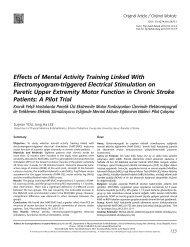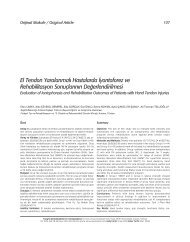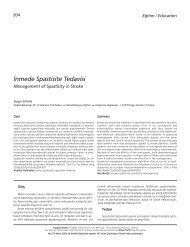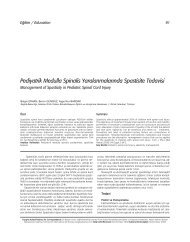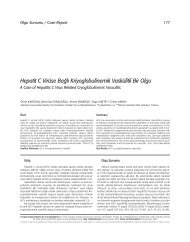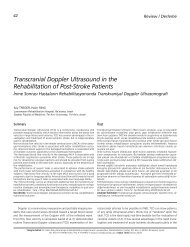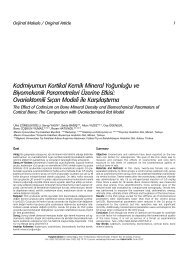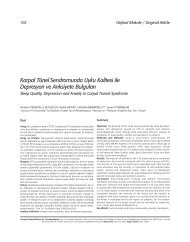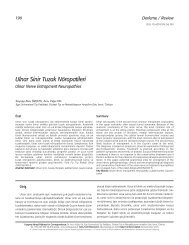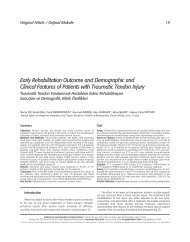‹nmeli Hastalarda Yaflflam Kalitesini Etkileyen ... - FTR Dergisi
‹nmeli Hastalarda Yaflflam Kalitesini Etkileyen ... - FTR Dergisi
‹nmeli Hastalarda Yaflflam Kalitesini Etkileyen ... - FTR Dergisi
Create successful ePaper yourself
Turn your PDF publications into a flip-book with our unique Google optimized e-Paper software.
197<br />
23. Ulusal Fiziksel T›p ve Rehabilitasyon Kongresi / 23 rd National Physical Medicine & Rehabilitation Congress<br />
Türk Fiz Rehab Derg 2011:57Özel Say›; 1-334 /Turk J Phys Med Rehab 2011:57Suppl; 1-334<br />
P-086<br />
Subkortikal Bant Heterotopisi: 2 Olgu Sunumu<br />
Zehra Kocaa¤a 1, Tufan Özkayran 2<br />
1Özel Ünye Çak›rtepe Hastanesi Fiziksel T›p ve Rehabilitasyon Klini¤i, Ordu<br />
2Özel Ünye Çak›rtepe Hastanesi Nöroloji Klin¤i, Ordu<br />
Subkortikal bant heterotopisi (SBH) s›n›rl› veya yag›n nöronal migrasyon bozuklu¤udur.<br />
SBH'nin iki ana klinik bulgusu kognitif bozukluk ve epilepsidir. Mental yetiler normal duzeyden<br />
agir mental retardasyona kadar farkliliklar gosterebilirler. Tutulan beyin bolgesine bagli<br />
olarak klinik ozelikler de¤iflebilir ve fokal norolojik bulgular, epileptik nobetler olarak saptanabilir.<br />
Biz burada baflka klinik problemler ile polikini¤imize baflvuran ve rutin fizik muayene esnas›nda<br />
asemptomatik, silik fokal nörodefisit saptad›¤›m›z, etyolojik araflt›rma sonucunda<br />
SBH tan›s› koydu¤umuz 2 vakay› sunmay› amaçlad›k.<br />
Olgu 1: 41 yafl›nda bayan hasta boyun ve s›rt a¤r›s› nedeni poliklini¤imize baflvurdu. Yap›lan fizik<br />
muayenede boyun ve s›rtta paravertebral kas spazm› ve tetik noktalar saptand›. Boyun<br />
romlar› hareket sonu minimal a¤r›l›yd›. Sa¤ parmak abduksiyon ve adduksiyonda kas gücü<br />
4+/5 saptand›, di¤er nörolojik muayenesi ola¤and›. Yap›lan etyolojik araflt›rmada yap›lan servikal<br />
magnetik resonans görüntüleme (MRG) ve elektrofizyolojik de¤erlendirimelerinde fizik<br />
muayene bulgusunu aç›klayacak herhangi bir patoloji saptanmad›. Hasta nöroloji poklini¤ine<br />
yönlendirildi. Hastan›n çekilen kranial MRG’de subkortikal bant heterotopisi saptand›.<br />
Olgu 2: 46 yafl›nda erkek hasta sa¤ omuz a¤r›s› nedeni poliklini¤imize baflvurdu. Yap›lan fizik<br />
muayenede boyun ve s›rtta paravertebral kas spazm› ve tetik noktalar saptand›. Omuz hareket<br />
açkl›¤› tam ve a¤r›s›zd›, özel omuz testleri negatifdi. Sol el bile¤i dorsi ve plantar fleksiyonu<br />
4+/5, sol parmak abduksiyon ve adduksiyon 4+/5, solda hipotenar atrofi saptand› di¤er<br />
nörolojik muayenesi ola¤and›. Yap›lan etyolojik araflt›rmada yap›lan MRG ve elektrofizyolojik<br />
de¤erlendirimelerinde fizik muayene bulgusunu aç›klayacak herhangi bir patoloji saptanmad›.<br />
Etyolojik aç›dan de¤erlendirilmek üzere hasta nöroloji poklini¤ine yönlendirildi. Hastan›n<br />
yap›lan kranial MRG de subkortikal bant heterotopisi görüldü.<br />
Nörolojik defisiti olan hastalarda ilgili sinir kökü ve periferik sinir ile iliflkili patoloji saptanmazsa<br />
efllik edebilecek sessiz SBH ak›lda tutulmal›d›r.<br />
Anahtar Kelimeler: Nöronal migrasyon, bant heterotopi, nörodefisit<br />
P-087<br />
Tethered Kord Sendromu, ‹ntradural Epidermoid Kist ve<br />
Lipom Birlikteli¤i: Olgu Sunumu<br />
‹rfan Koca 1, Ercan Madenci 2, Özlem Alt›nda¤ 2, Ekrem Karakafl 3,<br />
Ali Gür 2, Bahattin Çelik 4<br />
1fianl›urfa E¤itim ve Araflt›rma Hastanesi Fizik Tedavi ve Rehabilitasyon Klini¤i, fianl›urfa<br />
2Gaziantep Üniversitesi T›p Fakültesi Fizik Tedavi ve Rehabilitasyon<br />
Anabilim Dal›, Gaziantep<br />
3fianl›urfa E¤itim ve Araflt›rma Hastanesi Radyoloji Klini¤i, fianl›urfa<br />
4fianl›urfa Bal›kl›göl Devlet Hastanesi Beyin Cerrahi Klini¤i, fianl›urfa<br />
Tethered kord sendromu (TKS) konjenital ya da edinsel nedenlerle omurili¤in gerilmesi ile ortaya<br />
ç›kan, ilerleyici nörolojik kay›plar ile karakterize bir hastal›k grubudur (1). Bu yaz›da nadir<br />
olarak rastlanan TKS, intradural epidermoid kist ve lipom birlikteli¤i, MRG eflli¤inde sunulmufltur.<br />
On yedi yafl›nda bayan hasta, bel ve her iki bacakta a¤r› ve uyuflma flikayeti ile <strong>FTR</strong> poliklini-<br />
¤imize baflvurdu. fiikayetlerinin yaklafl›k 5 ayd›r devam etti¤ini ve kulland›¤› ilaçlardan fayda<br />
görmedi¤ini ifade ediyordu. Hastan›n gayta ve idrar inkontinans› flikayeti mevcuttu. Fizik muayenesinde<br />
bel ve kalça hareketleri her yöne tam aç›kt›. Laseque testi bilateral 60 derecede<br />
müsbet, Faber ve Fad›r testleri ise menfi idi. Motor kay›p yoktu. Her iki bacakta L5-S1 dermatomlar›nda<br />
hipoestezi tarifliyordu. Aflil refleksi al›namad›. Sedimentasyon ve CRP normaldi.<br />
Hastan›n çekilen lomber MRG’de: Konus medullaris L3 vertebra korpus inferior kesimine dek<br />
uzan›m göstermekteydi (tethered kord). Bu düzeyden kaynaklan›p inferiora do¤ru uzan›m<br />
gösteren yaklafl›k 32x17 mm boyutlar›nda, ekstrameduller, intradural yerleflimli, T1'de BOS'a<br />
göre hafif hiperintens görünümde, T2 a¤›rl›l› görüntülerde hiperintens, kontrastl› serilerde hafif<br />
ince duvar kontrastlanmas› gösteren ilk planda epidermoid kist ile uyumlu olabilecek kitlesel<br />
lezyon ve bunun anterior komflulu¤unda yaklafl›k 10x3 mm boyutunda ve L2-3 düzeyinden<br />
geçen kesitlerde spinal kord posterior kesiminde yaklafl›k 15x7 mm boyutlar›nda, intradural<br />
ekstrameduller lipoma ait görünümler izlenmekteydi. Bunun üzerine al›nan beyin cerrahi konsültasyonu<br />
sonucu hastaya operasyon önerildi.<br />
Bel a¤r›s› ve bacaklarda a¤r› ve uyuflma flikayeti ile baflvuran hastalar›n ayr›c› tan›s›nda tethered<br />
kord sendromu da ak›lda tutulmal›d›r. Bizim olgumuz tethered kord sendromu, intradural<br />
epidermoid kist ve lipom ile birlikteli¤i ile çok nadir olarak karfl›lafl›lmas› bak›m›ndan önemlidir.<br />
Bu tür hastalarda erken teflhisle tedavinin baflar› flans›n› art›rmak için MRG’nin önemi<br />
ihmal edilmemelidir.<br />
Anahtar Kelimeler: Tethered kord sendromu, epidermoid kist, lipom<br />
P-086<br />
Subcortical Band Heterotopia: Report of Two Cases<br />
Zehra Kocaa¤a 1, Tufan Özkayran 2<br />
1 Ünye Çak›rtepe Hospital Physical Training and Rehabilitation Clinic, Ordu<br />
2 Ünye Cak›rtepe Hospital Neurology Clinic, Ordu<br />
Subcortical band heterotopia (SBH) is a focal or diffuse neuronal migration disorder. Two<br />
cardinal clinical findings of SBH are cognitive dysfunction and epilepsy. Mental capacity may<br />
vary from normal to severe mental retardation. The clinical picture may vary according tothe<br />
involved brain region and focal neurological deficits and epileptic seizures may be seen. Here<br />
we present two cases applied to our clinic with irrelevant complaints and a routine physical<br />
examination revealed slight focal neurological deficit and diagnosed as SBH during etiological<br />
investigation.<br />
Case 1: A 41 year old female patient presented with neck and back pain to our clinic. We found<br />
paravertebral muscle spasm and trigger points in the physical examination. The neck roms<br />
were minimally painful at the end of motion. The muscle strength of her right thumb was<br />
4+/5 at abduction and adduction and the rest of the neurological examination was normal.<br />
There was not any pathological finding on cervical magnetic resonance imaging (MRI) and<br />
electrophysiological study to explain her physical examination finding. The patient<br />
was referred to the neurology department and her cranial MRI showed subcortical band<br />
heterotopia.<br />
Case 2: A 46 year old man presented to our clinic with right shoulder pain. We found<br />
paravertebral muscle spasm and trigger points during physical examination. His range of<br />
motion at the shoulder was intact and painless, and specific shoulder tests were negative. His<br />
left wrist dorsiflexion and plantar flexion were 4+/5, left thumb abduction and adduction<br />
were 4+/5, he had left hypothenar atrophy and the rest of the neurological examination<br />
was normal. There was not any pathological finding on cervical MRI and electrophysiological<br />
study to explain her physical examination findings. The patient was referred to the<br />
neurology department and on his cranial MRI band heterotopia was seen.<br />
In patients with neurological deficits, if we do not find a pathology related to nerve root or<br />
peripheral nerve we must remember accompanying silent SBH.<br />
Keywords: Neuronal migration, band heterotopia, neurodeficit<br />
P-087<br />
Tethered Cord Syndrome in Collaboration With Intradural Epidermoid<br />
Cyst and Lipoma: A Case Report<br />
‹rfan Koca 1, Ercan Madenci 2, Özlem Alt›nda¤ 2, Ekrem Karakafl 3,<br />
Ali Gür 2, Bahattin Çelik 4<br />
1 Sanliurfa Hospital of Education and Investigation Department of Physical Therapy and<br />
Rehabilitation, Sanliurfa<br />
2 Gaziantep University Faculty of Medicine Department of Physical Medicine and<br />
Rehabilitation, Gaziantep<br />
3 Sanliurfa Hospital of education and investigation Department of Radiology, Sanliurfa<br />
4 Balikligol Hospital Department of Neurochirugy, Sanliurfa<br />
Tethered cord syndrome (TCS) is a group of disease nomenclature with progressive neurological<br />
deficiencies caused by the tension of spinal cord and the etiology may be congenital<br />
or acquired (1). In this document we report a rare TCS case caused by intradural epidermoid<br />
cyst and lipoma accompanying with magnetic resonance images.<br />
A 17 year old previously healthy girl with a history of low back, lower extremity pain and<br />
numbness for5 months and failed to improve despite medical management. She was complaining<br />
of fecal and urinary incontinence. Physical examination revealed completely normal<br />
lumbar and hip motions. Laseque test was positivebilaterally at 60 degrees. Faber and Fad›r<br />
tests were negative. No motor deficiency was found and both lower extremities showed<br />
hypoesthesia in L5-S1 dermatomas. Achilles reflex was negative. Sedimentation and CRP levels<br />
were normal. Lumbosacral MRI showed tethered cord with spinal cord endingat the level<br />
of L3. At this level a mass, located extramedullary, intradural, measured 32x17 mm, slightly<br />
hyperintense in T1 weighted images, hyperintense in T2 weighted images, with a thin wall<br />
contrast, extending inferiorly was thought to be an epidermoid cyst. In its neighborhood,<br />
anteriorly to this mass anothermass measured 10x3 mm, located intramural, extramedullary<br />
and another mass posterior to the spinal cord at the level of L2-3, measured 15x7 mm,<br />
located intramural, extramedullary was thought to be lipomas were found in the MR images.<br />
The operation was recommended to the patient after being consulted by neurosurgery<br />
department.<br />
Patients complaining with low back pain, lower extremity pain and numbness,<br />
TCS should be kept in mind by the clinician. Our TCS case is affective because of<br />
theaccompanying intradural epidermoid cyst and lipoma. So patients accompanying with<br />
these symptoms MR imaging is essential for diagnosis.<br />
Keywords: Tethered cord syndrome, epidermoid cyst, lipoma



